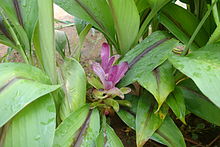- Black Turmeric
-
Black Turmeric 
Scientific classification Kingdom: Plantae (unranked): Angiosperms (unranked): Monocots (unranked): Commelinids Order: Zingiberales Family: Zingiberaceae Genus: Curcuma Species: C. caesia Binomial name Curcuma caesia
Roxb.Black Turmeric (Curcuma caesia) is a perennial herb with bluish-black rhizome,[1] native to North-East[2] and Central India. Black Turmeric is also sparsely found in Papi Hills of East Godavari, West Godavari, and Khammam Districts of Andhra Pradesh. The rhizomes of Black Turmeric have a high economical importance owing to its putative medicinal properties. Presently Black Turmeric is on the verge of extinction due to unfavorable climatic changes, deforestration, soil erosion and bio-piracy.[citation needed]
Contents
Common names
(Hindi: काली हल्दी Kali Haldi, Nar Kachura, कृष्ण केदार Krishna kedar; Manipuri: Yaingang Amuba or Yaimu; Marathi: काला हल्दी Kala-haldi; Telugu: Nalla Pasupu; Kannada: kariarishina, naru kachora; Bengali: Kala haldi; Mizo: Aihang, Ailaihang; Assamese: kala haladhi; Nepalese: कालो हलेदो Kaalo haledo) "marathi madhe kali hald mhantat"
Identification
The leaves have a deep violet-red patch which runs through the length of the lamina. Usually, the upper side of the leaf is rough, velvety, but this characteristic may vary. Flowering bracts are green with a rustic tinge. Flower petals may be deep pink or red in color. The inside of the rhizome is deep-blue or bluish-black in color. The rhizome slightly resembles the light-grey rhizome of Curcuma Aeruginosa.
Chemical constituents
The research on the volatile rhizomes oil of Curcuma caesia resulted in the identification of 30 components, representing 97.48% of the oil, with camphor (28.3%), ar-turmerone (12.3%), (Z)-ocimene (8.2%), ar-curcumene (6.8%), 1,8-cineole (5.3%), elemene (4.8%), borneol (4.4%), bornyl acetate (3.3%) and curcumene (2.82%) as the major constituents.[citation needed]
Medicinal uses
The rhizome has a bitter, hot taste and a pungent smell. It is claimed to be useful for treating Hemorrhoids , leprosy, bronchitis, asthma, cancer, HIV/AIDS, epilepsy, fever, wounds, impotency, fertility, menstrual disorders, toothache, vomiting etc.
Tribal practices
Gondi people use the rhizomes for various medicinal purposes. In case of gastric troubles, they chew a small piece of fresh rhizome. In case of wounds or cuts or leprosy, they apply fresh juice of rhizome externally.North-Eastern Indian tribes use Black Turmeric as a talisman to keep the evil spirits away.
Traditional quality tests
Place white papers one over the other. Take a fresh piece of black turmeric and sharp it like a pencil. Gently press the rhizome on the top most paper and draw few parallel lines on it. Some time later, black lines are traced on the papers below. The number of papers that are traced determines the quality of the rhizome. Another test is that - the pure Camphor melts in few minutes when it is placed on fresh cut rhyzome. But these traditional tests still remains a debate, whether true or not.
Other uses
The dried leaves of Black Turmeric are used as a source for fuel. It is used as Tantrik Sadhana and in Goddess Kali's Puja.
Significance of the name
Hindu goddess Kali, is associated with darkness, death, and destruction. In Hindi, Kali means “the black one,” and this meaning has several synonyms. The goddess is the destroyer of evil spirits, for why in most artwork, her skin is dark black or blue. By plant taxonomy, the word Caesia means blue color. But in West Bengal, the rhizome of Curcuma Caesia is used in Goddess Kali Puja. For this reason Curcuma Caesia is called by name Kali Haldi in Bengali or Kala Haldi in Hindi. Since the word Kali, which is attributed to Goddess Kali, literally means black, Curcuma Caesia is vernacularly known as Black Turmeric.
In Mahabharatha, Lord Krishna is depicted as blue or black skinned character. Secondly, Krisha Paksha, the second half of any month bears the name because of moonless day which is dark. Also by Astronomy, Black Hole is translated as Krishnabila in Telugu. Hence the word Krishna can also mean black or blue color by etymology. Hence Curcuma Caesia is called Krishna Kedara in Hindi since the inside of the rhizome is stunning blue in color.
Cultivation and harvest
The cultivation and harvest practices are similar to that of common Turmeric which is used in recipes. In the fields, the rhizomes are washed thoroughly and are placed in a wide mouthed couldron. The water is poured in the couldron such that the rhizomes are completely sunk. The couldron is covered with a lid, and the rhizomes are boiled for about 30 minutes until foam oozes out with strong odour. The rhizomes are taken out whilst the water is reduced to one-third of its content and when they turn soft with their inner portion decolorized from blue to dark or pale brown. The rhizomes are then dried in hot sun for 10 to 15 days until they are hardenend. These dried rhizomes are then packed for marketing.
References
- ^ Syamkumar, S.; B. Sasikumar (March 2007). "Molecular marker based genetic diversity analysis of Curcuma species from India". Scientia Horticulturae 112 (2): 235–241. doi:10.1016/j.scienta.2006.12.021.
- ^ Ravindran, P. N.; K. Nirmal Babu, K. Sivaraman (2007). Turmeric: The Genus Curcuma. CRC Press. p. 11. ISBN 9780849370342.
Categories:- Herbs
- Zingiberaceae
Wikimedia Foundation. 2010.


